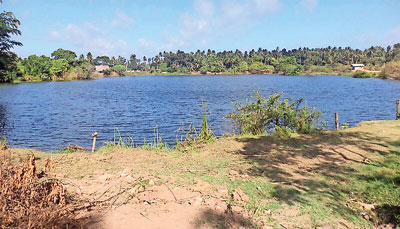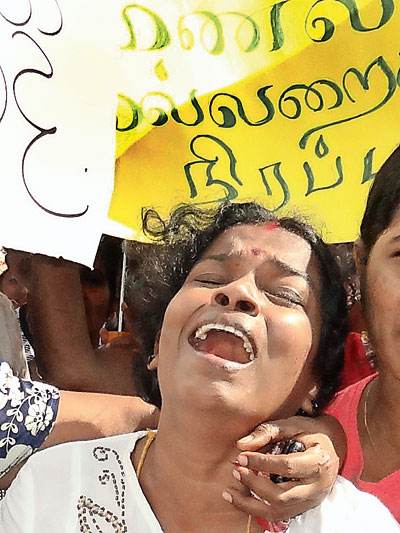News
Hundreds of deathtraps left by lax sand miners
View(s):Gem areas also riddled with dangerous pits
By Chrishanthi Christopher

Udangawa pit. Pix by Hubert Fernando
The hundreds of gaping pits abandoned by sand miners are death traps, authorities said, following community outrage over the deaths of two children who drowned in a pit – and the same problem exists in gem mining areas.
Residents of Kochchikade, near Negombo, where the two children died after drowning on September 30 while swimming in a sand pit that had filled up with water, held a large protest last week to demand immediate action to fill up pits left by miners.
Extensive digging is taking place down the Chilaw Road in areas including Katana, Thopuwa, Jambugaswatte and Halpe.
Katana Divisional Secretary K.G.H.R. Kirella said large-scale sand excavation is being allowed by the Geological Survey and Mines Bureau (GSMB) but there was little monitoring to ensure the pits were filled after mining. He said that the pits are veritable death traps to area residents.
Mr. Kirella said sometimes even when the Divisional Secretary of the area recommends against a mining application miners are granted licences to dig. The issuing of licences by the GSMB is contingent on approval from the Divisional Secretary and an environment clearance certificate from the Central Environment Authority.
The pits were also dug deeper than the permitted depth with miners extracting more than the permitted volume of sand – again with no monitoring by the GSMB, Mr. Kirella said.
The GSMBsaid some pits had been dug before the bureau began issuing licences in 1993. And the bureau’s Chairman, Dr. D.M.D.O.K. Dissanayake, said pits were more than 20-30 years old. “This has been happening over time,” he said.

Child's mother
GSMBEngineer S. de Silva said the depth to which pits could be excavated is specified when licences are granted and miners are expected to rehabilitate the land by filling them up. “But this is not happening. Miners are violating the conditions of the permits,” he said.
Moreover, he said, there was illegal mining and the GSMB was unable to control this because legal action could not be taken against offenders where there was no licence.
The GSMB takes bank guarantees to issue licences but, Mr. de Silva said, the money was insufficient to have the massive pits filled.
The bureau said it was having discussions on closing the pits and examining ways of tightening conditions for licensing and preventing illegal sand mining.
The country’s gem mining areas are also facing the same problems. Ratnapura Divisional Secretary Chitra Kottawatha said huge pits have been dug up and abandoned by gem miners. Ratnapura has more than 25 huge water-filled pits that have become death traps. A month ago, a child flying a kite fell into a pit and died.
Miners did not fill in pits after mining ended. “They do not bother to take back their deposits when they find valuable gems,” Mrs. Kottawatha said.
Stagnating water in the pits have become breeding grounds for dengue mosquitoes and there has been a spike in the number of dengue patients in Ratnapura.
Other areas with abandoned pits include Kahawatte, Eheliyagoda, Balangoda, Pelamulla, where large-scale gem mining is in progress.

Protesters
| Abandoned mines turn into lakes There about 125 gem pits, many up to 20 years old, in the Ratnapura district and some abandoned pits have become lakes after filling with water, Gem Authority (GA) Chairman, Asanka Welegedera said. Miners are expected to restore the land within two months of the lease period ending or face confiscation of the deposits but, Mr Welegedera said, even though deposits came to Rs. 1-2 million these sums were inadequate to carry out restoration work. Illegal mining and mining on private property were adding to the problem, the GA Chairman said. He said a draft bill was being prepared to take legal action against miners who violate licensing conditions and is to be presented to parliament next February. The law currently does not allow legal action against miners who abandon mined land with pits unfilled. In the meantime, the GA has allocated Rs. 33 million to fill up open pits in the Ratnapura districts. Mr Welegedera said 25 mechanised pits need immediate attention. Some pits have turned into artificial lakes and are being used by farmers for cultivation. The GA has agreed with the district farmers’ association to keep them as a water source. Licences for mechanised gem mining have ceased being issued and miners who have violated licensing conditions in the past are not being issued with fresh licences, the GA said.Deposits are charged on the number and the size of the pits leased. A manually-dug pit of an area measuring 8 x 6 cubic feet would cost Rs. 5,500. Regulations require that mining is done away from residential area, private property and roads.
|

